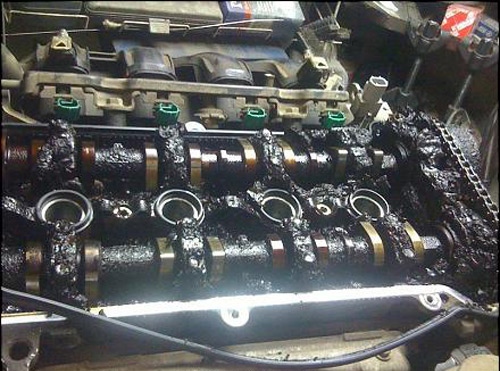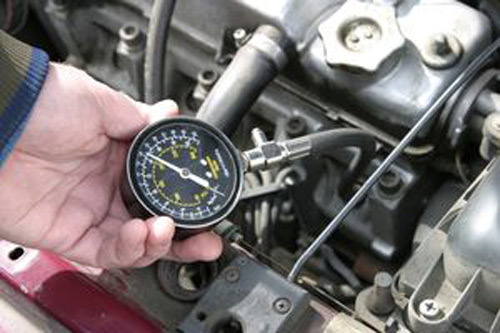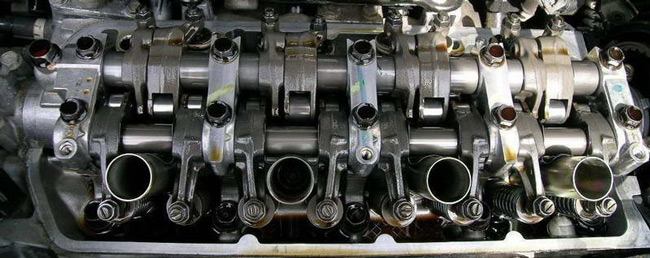Every car enthusiast whose “iron friend” has served him for quite a long time has encountered the problem of engine decompression. The vast majority of car services in such cases recommend making major repairs. However, this procedure is quite expensive and, as practice shows, not always really necessary. In many cases, the solution to this problem came down to a simpler question: how to decarbonize an engine with your own hands? Is this procedure really necessary and so simple that a trip to a car service is not necessary?
What is engine coking and why is it dangerous?
During the operation of a car, we, unfortunately, constantly encounter things that can subsequently create a huge number of problems for our cars. For example, constantly sitting in traffic jams is harmful not only to our nerves: prolonged operation of the engine at low speeds significantly increases the formation of carbon deposits on the walls and bottom of the fuel chamber, as well as on the valves. The same effect can be caused by using low-quality fuel or unsuitable oil, driving “cold”, etc. This carbon deposits are formed due to incomplete combustion of the fuel mixture, and then aggravated by tiny carbon particles in the exhaust gases. The formation of this carbon deposit is called engine coking.

In order to answer the question of whether decoking the engine will help, we will try to understand what the coking of the unit actually means for the car.
- Carbon deposits increase the thickness of the cylinder walls, increasing the thermal load due to poor heat dissipation.
- Considering that carbon deposits trapped under the valve prevent it from fitting tightly to the seat, it is quite possible for the valve to burn out.
- The play between the valve walls and the piston rings decreases, which leads to their “stacking” - the tightness of the combustion chamber is broken, compression is reduced, in some cases the rings simply physically break.
- The engine begins to “eat” due to decreased mobility of the piston rings.
- Due to pressure surges in the combustion chamber, detonation phenomena occur, which quickly “kill” the engine.
In general, there is little pleasant, as they say, and almost all of the listed consequences lead to a trip to the service center for a major engine overhaul.
To the service or to the garage
If the exhaust in your car has acquired a characteristic black color, power has dropped, and fuel and oil consumption has increased - most likely your car has a problem with the engine. The verdict of most car services is a major overhaul. However, there is another option that, quite possibly, will resolve all issues in one fell swoop. This method is to remove carbon deposits formed during operation and decarbonize the unit.
How to decarbonize an engine? Is it necessary to go to a car service center or can the problem be solved with “little blood” and with the help of your own skillful hands? The question has several possible answers.
First, you need to understand what exactly needs to be done and how. If previously the “hard” decoking method was used almost everywhere, which meant pouring a special mixture directly into each cylinder, now there are more options and some of them do not involve any intervention in the aggregate part at all.
Secondly, you need to decide (if the method of complete decoking is chosen) to independently carry out this action.
If you have decided to go to a car service center, then what follows will be useful for you only from an educational point of view. If decarbonizing the engine with your own hands does not scare you, first of all you need to determine the appropriate method for yourself.
To each his own: methods for engine decarbonization
Partial decarbonization method (“soft”)
This method involves adding a special liquid to the oil shortly before changing it - after adding the liquid, you can drive this oil for a hundred or two kilometers without loading the engine, and then immediately change it. It is not possible to perform a complete cleaning using this method because the carbon remover does not enter the combustion chamber. Only the most frequently stuck oil scraper rings are cleaned. However, the method is low-cost and as simple as possible, so it can be recommended as a preventative before each oil change - such a procedure certainly will not be superfluous. It is also very important to understand that by pouring such a product, we dilute the oil, which means driving at high speeds before changing the oil will be strictly contraindicated.
Complete decarbonization method (“hard”)
This is a method that requires some effort and time. However, it is this that will allow you to completely clean the engine of carbon deposits.

Carrying out a complete decarbonization
To carry out a complete cleaning, you need to place the car horizontally (as if changing the oil) and warm up the engine to operating temperature to create a “steam bath” effect. Next, we perform the following actions:
- Remove nozzles or unscrew.
- Use a screwdriver or wire to place all the pistons in the middle position, turning. The average position of the pistons is determined by the different wear of the cylinders in height and the required amount of product. When the pistons are in a position close to the middle, there is no excess fluid consumption and it better penetrates into all the necessary gaps.
- Using a syringe (it’s more convenient to measure an equal amount and get it exactly) we pour a special product into the cylinders (for example, Winns or domestic LAVR ML-202), light the candles and leave the liquid in the cylinders for the time specified in the instructions. Usually this time ranges from an hour to a day, however, in the case of using special decarbonizing preparations, this time can be increased up to several weeks.
- When carrying out quick decarbonization (for an hour or a little more), it is necessary to periodically rotate the crankshaft in different directions by 5–10 degrees for better distribution of the product.
- Having previously covered the spark plug wells with a rag to prevent dirt from scattering, we turn the crankshaft to completely remove the cleaning fluid from the combustion chamber.
- We twist the candles and start the engine. Let it idle for about 60 minutes.
- Change the oil and...
Possible problems with the method
The described method was used by our grandfathers and decoking of the engine with their own hands was done quite often: the quality of fuel and oil was not at all the same as now, and Soviet people preferred not to go to services, doing it themselves. In those days, they did not pour special products, but mixed kerosene and acetone in half. In principle, the same effect was achieved, but there is a small nuance. When carrying out a complete cleaning of carbon deposits, the oil is completely washed out from the cylinder walls. Thus, the first start of the engine after draining the mixture into the crankcase occurs “dry”, which can lead to the formation of so-called scuffing and wear of the piston rings. Current tools address this problem. For example, when decoking, LAVR creates a special film on the cylinder walls, which prevents the formation of scuffs and subsequently significantly reduces the adhesion of carbon deposits.
It is also necessary to take into account that complete cleaning is carried out using fairly highly toxic substances, so it is imperative to provide good ventilation in the room where the decarbonization procedure will be carried out.
Another problem is related to the location of the cylinders in the engine. The easiest way to apply this method is on conventional in-line engines. In the case of a V-shaped or opposed cylinder arrangement, the procedure is slightly more complicated, although the general essence is the same. The differences include more difficult access to the spark plugs and the need to almost completely cover the piston with liquid. For example, when decarbonizing boxer engines, the liquid can be “pressed” by rotating the crankshaft on the compression stroke, thus ensuring that the entire volume of the combustion chamber is filled.

There is also an interesting paradox: in old cars with significant mileage, complete decarbonization may not only not improve engine performance, but, on the contrary, reduce compression. This happens when the parts already have significant wear and carbon deposits act as a seal between engine elements. By washing away the carbon deposits, we will increase the gap between the piston and the cylinder and, therefore, reduce the compression. Thus, in the case of an old car, you need to think about whether decarbonizing the engine will help or, conversely, will worsen the situation.
And the biggest problem with this method is the duration. Although express decarbonization within an hour is possible, this method does not always guarantee absolute cleaning of the entire combustion chamber from carbon deposits. To be sure, you need to leave the car inoperative for a long time.
Additive method
The simplest, but time-consuming method. Its essence is to pour a special product (for example, EDIAL decarbonizer) directly into the fuel tank, from where it enters together with the fuel directly into the combustion chamber. Penetrating into the thickness of soot, particles of the decarbonizing agent provoke its complete burnout and go with it into the exhaust.
The advantages of this decarbonization method are, firstly, that there is no need to disassemble the car and leave it inoperative. Secondly, fill the full tank with the required amount of product, you don’t think in what mode you need to drive - decarbonization occurs in this case, the better, the higher the load on the engine. Another important difference is that there is no need to change the oil after the procedure, since the product, unlike the “hard” method, does not enter the crankcase.
What's the result?

We hope that after reading this material you will not have a question about whether engine decarbonization is necessary. If the car is not old, such a procedure will either completely solve the problems with decompression, loss of power and black smoke from the chimney, or it will show that the case is completely advanced and cannot be avoided without a major overhaul.
In general, we definitely recommend that, before preparing money for capital, you try to decarbonize the engine yourself using any method convenient for you - there is a fairly high probability that you will save time and money. Many car enthusiasts, sharing their experiences, point to a decrease in fuel and oil consumption, an improvement in the dynamic characteristics of the car and the disappearance of black exhaust gases after decarbonization.
In any case, the formation of carbon deposits, in the case of periodic use when changing oil, a soft decarbonization method, will not hurt.
We wish you success, and your car smooth cylinders and shiny pistons!







